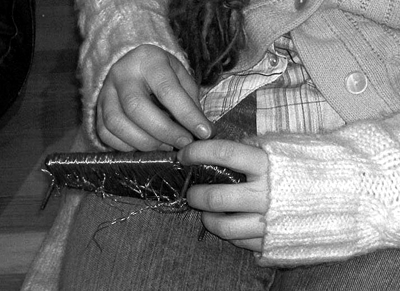WRAP UP!
Co-op Provides Hands-on Experience
By Jill Bugajski and Heather Birkhead
 The
exhibition Jin Soo Kim: Twenty Years, 1983-2003, now at the
Chicago Cultural Center, is the culmination of a year of anticipation,
reconstruction, and installation. The Cooperative Education
Program (Co-op) partnered with Associate Professor in Sculpture
Kim for more than a year in preparation for this retrospective.
Co-op student assistants John Welter, Alexis Elton, Susan
Dwyer, and Lynne Clarey helped Kim bring the show to fruition
and gained much experience during the process.
The
exhibition Jin Soo Kim: Twenty Years, 1983-2003, now at the
Chicago Cultural Center, is the culmination of a year of anticipation,
reconstruction, and installation. The Cooperative Education
Program (Co-op) partnered with Associate Professor in Sculpture
Kim for more than a year in preparation for this retrospective.
Co-op student assistants John Welter, Alexis Elton, Susan
Dwyer, and Lynne Clarey helped Kim bring the show to fruition
and gained much experience during the process.
John Welter worked as a Co-op student in Kim’s studio for the spring semester
of 2002. Welter had the opportunity to participate in the formation of the show
from its earliest stages — preparing and
finalizingsculptures and installations that were
to be included. Notetaking, brainstorming, and conceptualizing the space were
all logistical tasks, but finalizing and wrapping sculptures was the order of
the day. Welter said, “Wrap-ping the copper wire became the most methodical
practice in my life. I would spend eight hours lost in the movement of my body,
the bend of the wire, and the physical beauty of the sculpture. Seeing Jin Soo’s
approach to art making and her enga-gement with the studio was both informative
and inspiring. I left this job with a broader understanding of how artists can
use their studio as creative fodder.”
Alexis Elton added: “You have
to let go while in the obsessive wrapping. The repetition
can be crazy if you don’t let yourself go into the movement.”
During the summer semester 2002, Alexis was Kim’s Co-op
student, and then returned this past winter session to assist
with installation at the Cultural Center. We spoke with Elton,
Dwyer, and Clarey at the Cultural Center before the opening
of the show; all three continued to wrap small educational
works that could be handled and explored by children visiting
the exhibition.
The Twenty Years show is an auditory
and visual feast. The sculptural works are dissonantly trapped
between the sountrack of Kim’s “Tunnel”
(2002) at the east end of the gallery, and the incessant clock-
ticking component of the DVD installation at the west end.
Young Sun Han, a former Co-op student, collaborated on the
production of this soundscape. Time was critical: all Co-op
students contributed more than 700 hours to make Jin Soo’s
retrospective a success.
All concur that working on an exhibition
with such heavy sculptures was physically draining, yet extremely
rewarding. Having the opportunity to see the individual works
recontextualized and evolved into a complex installation meant
that perspectives were constantly shifting. Elton worked with
Kim to begin the new site-specific piece “Prepositions”
for this exhibition. All of the elements of “Prepos-itions”
are objects or parts of works from past installments. As they
visualized, developed, and accumulated components for this
work, Elton was thinking of the relationship of deconstruction
to construction: “We have all gotten physically and
mentally stronger from doing this.”
Elton and Clarey prepared all the sculptures for transport
from Kim’s Evanston studio: “It was a strange
relationship after wrapping the work itself for hours, but
then to have to wrap all of the work to protect it while it
traveled to the Cultural Center seemed redundant though absolutely
necessary to protect the work.”
As a Co-op studio assistant, Susan
Dwyer began working in Kim’s studio in the fall semester
of 2002, and continued through the winter semester to install
the show. Dwyer literally worked from the ground up, from
painting the studio floors, to raising Kim’s eight-foot
tall sculptural walls, to seeing the suspension of works from
the Cultural Center’s high ceiling. “For as many
frustrations as I’ve had, and different work I have
done, it has been a neat experience because of the wonderful
mentoring relationship.” Dwyer is an experienced Co-op
student. Before she worked with Kim, her first Co-op job was
as an assistant to a painter. Susan emphasized the benefits
of working with someone both within and outside of her field
of study. For other students thinking about working as an
artist’s assistant through the Co-op Program, Dwyer
says: “Know what you want to get out of the artist before
you go into the Co-op position, but be willing to be flexible
and open to any possibilities.”
For information about Co-op, stop
by the Co-op Program office in Sharp 707. Photograph courtesy
of Co-op.
 The
exhibition Jin Soo Kim: Twenty Years, 1983-2003, now at the
Chicago Cultural Center, is the culmination of a year of anticipation,
reconstruction, and installation. The Cooperative Education
Program (Co-op) partnered with Associate Professor in Sculpture
Kim for more than a year in preparation for this retrospective.
Co-op student assistants John Welter, Alexis Elton, Susan
Dwyer, and Lynne Clarey helped Kim bring the show to fruition
and gained much experience during the process.
The
exhibition Jin Soo Kim: Twenty Years, 1983-2003, now at the
Chicago Cultural Center, is the culmination of a year of anticipation,
reconstruction, and installation. The Cooperative Education
Program (Co-op) partnered with Associate Professor in Sculpture
Kim for more than a year in preparation for this retrospective.
Co-op student assistants John Welter, Alexis Elton, Susan
Dwyer, and Lynne Clarey helped Kim bring the show to fruition
and gained much experience during the process.